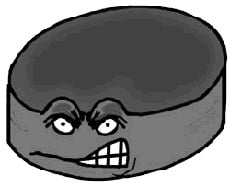
As hope fades for a National Hockey League season, it’s hard to feel any sympathy for team owners. They are obviously pulling yet another off-ice power play against the players in their long-running quest for dominance over not just them, but also over basic economic laws.
Some uninformed fans mistakenly call the hockey shutdown a “strike” and begrudge players their inflated salaries, which at last count averaged about US$1.8 million a season. But placing the blame on players ignores the essential fact of who closed the ice rinks. It wasn’t the players, and it isn’t a strike. It’s a lockout, because that’s exactly what the owners have done to the players. They’ve closed the doors to NHL arenas and promised not to open them again until the players agree to a salary system that guarantees the owners can’t lose the kind of money they’ve been frittering away on high-priced free agents for the past decade or so – or lose any money at all.
The owners have proven incapable of running their businesses in a responsible manner since their lockout of 1994-95, which lasted a half-season, but they have instead blamed the players for causing the problem. They have further demanded that the players provide the solution by accepting a salary cap set low enough to ensure profitability no matter how badly managed teams are.
This economic tug-of-war between millionaire players and billionaire owners has of course left hockey fans caught in the middle, deprived of their usual fall fare.
Brad Pitt can’t skate
But somehow fans seem more inclined to blame the players who are being prevented from suiting up for games than the team owners who have decided to apply economic pressure by withholding their pay cheques.
For some reason hockey fans seem to think players are less entitled to have their salaries determined by market forces than, say, movie stars or basketball players. No one seems to begrudge Brad Pitt or Tom Cruise $8 million or even more for making just one movie, and the average NBA salary is about US$5 million. But for some reason hockey players are seen more as overpaid, unskilled laborers than as talented performers.
The reasons we are unlikely to see NHL hockey at all this season are numerous. Both sides are dug in to their positions – the owners are bound and determined to wrest a salary cap from the players and the players are dead set against one. Both have enormous war chests saved up to see them through the dispute – the players from their rich salaries, and the owners despite their supposed losses. But the growing realization is dawning that team owners have a hidden agenda that has nothing to do with negotiating a resolution to the labor dispute. Instead it is increasingly obvious that the NHL plans on canceling the season and starting again next year with non-union replacement players. Taking such a precipitous step could change the face of hockey as we know it and even result in the death of the NHL.
Players offer good ideas
The players realize the business model of hockey is broken, and they are willing to do their part to help fix it. They have offered to take an across-the-board salary cut if the league will institute some basic economic reforms designed to address the cause of its financial problems and not just treat the symptoms. Rather than a salary cap like in the NBA or NFL, the players have suggested a luxury tax system such as is used to restrain salaries in Major League Baseball. This would have the added benefit of redistributing revenues from large-market teams that sign high-priced free agents to small-market teams, such as in Calgary and Edmonton, that are less able to afford them.
The root of the NHL’s economic problems lies in its lack of revenue sharing. NFL teams share about two-thirds of their revenues, which creates a level playing field on which teams in small markets like Green Bay, Wisconsin, can compete against large-market teams in New York and Chicago. Gate receipts, for example, are split 60-40 between home team and visitors in the NFL, and regular-season and playoff television revenues are split equally between all teams, whether they make the playoffs or not.
NBA and MLB teams share more than a third of their revenues league-wide, but NHL teams share only about nine percent. Home teams keep all gate revenues, and every team is left to negotiate its own local broadcasting contracts. Teams in large markets end up with loads of dough to blow on free agents, thus driving salaries up, while other teams run red ink in an attempt to keep up with inflation
Burned before
Another reason not to expect NHL players to give in easily to the league’s demand for a salary cap is the fact that before their recent prosperity players were exploited mercilessly for decades by team owners. Before Bob Goodenow came along as head of the NHL Players’ Association and instituted reforms to the system of salary negotiation, players were basically at the mercy of owners under the regime of Alan Eagleson. “The Eagle” lived in the pocket of owners for decades while he was head of the NHLPA, profiting personally from deal-making in international hockey while he was supposedly representing players at the bargaining table.
As former NHL president Gil Stein revealed in his memoirs, labor negotiations with Eagleson were a sham, with the settlement decided in a back room over drinks with owners. The pension benefits that players for years accepted under Eagleson’s reign rather than pursue free agency, as David Cruise and Allison Griffiths of Victoria detailed in their 1991 book Net Worth, were instead funded by monies that rightfully belonged to the players anyway.
Eagleson went to prison for the fraud he perpetrated upon NHL players, but he and the league avoided a multi-million-dollar lawsuit brought by retired players in the late 1990s only on the legal technicality that they had waited too long to file their claim. Ever since Eagleson departed the scene, NHL players have seen their fortunes multiply as Goodenow has ensured that market forces work in their favor.
Expanding avarice
NHL owners, driven by greed, expanded from 21 to 30 teams during the 1990s, pocketing $50 million and then $80 million per franchise, or as much as the market would bear. But in the end the joke was on them, as increasing the number of teams drove up the price for scarce free agents, who were only allowed their economic freedom at age 31 or 32 under the 1995 collective bargaining agreement. Twice the six-year deal was extended at the league’s request so it could expand in labor peace, but ultimately their greed came back to bite team owners in the wallet.
Free agency does not drive salaries up. It only allows the most basic of economic laws – supply and demand – to come into play. Now NHL owners want to repeal even that law and force a no-lose economic model on players. Hockey fans should at least realize whose ox is being gored. Of course, it’s theirs. And if the owners have their way, it will also be the players’.
Marc Edge is the author of Red Line, Blue Line, Bottom Line: How Push Came to Shove Between the National Hockey League and its Players (Vancouver: New Star Books), 2004. Contact him at [email protected]. ![]()















Tyee Commenting Guidelines
Comments that violate guidelines risk being deleted, and violations may result in a temporary or permanent user ban. Maintain the spirit of good conversation to stay in the discussion.
*Please note The Tyee is not a forum for spreading misinformation about COVID-19, denying its existence or minimizing its risk to public health.
Do:
Do not: